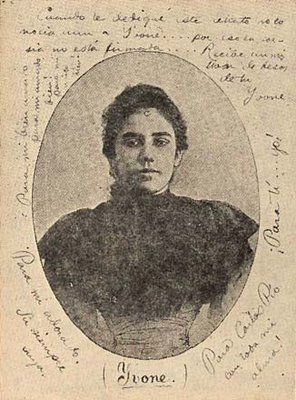3.8.4 The poetry and love letters of Juana Borrero (1878 – 1896)

According to Angel Augier, “In Cuban history, there is a parenthesis of astonishing intensity: that period of time that stretches between Zanjón and Baire, between the grief of defeat and the hope of victory; in that period of apparent peace, but of silent and muted war—and with which many identify the current Cuban moment—Juana’s life unfolded.”
Despite having died before turning 20 and unfortunately not having been able to fully develop her poetic instrument, her achievements, and above all, the great dose of authenticity that inspires the poet’s pages, should not be dismissed. Angel Augier describes her as a “tormented adolescent,” while acknowledging that adolescence is inherently a turbulent period, but the reasons that tormented the author were certainly deeper than usual at this stage.
Although her fibers also picked up the patriotic echoes of the impetus to fight colonialism, which sometimes revealed itself, sometimes contained itself in a difficult effort to submit, or sometimes postponed until a time when the entire community vibrated to the same warlike chord, Juana was above all driven by her need to create, an inescapable vocation that had deep family roots, both on her father’s and mother’s side of the family. Therefore, she chose a lofty destiny, a goal to which she would put everything and more, had she had the time.
Most of his childhood was spent in a manor house in Puentes Grandes, where he alternately came into contact with nature and art, to the point of blending them into a poetic whole. All of this stemmed from the educational vocation of his father, Esteban Borrero, who was responsible for teaching him the classics and generally building an environment conducive to creativity, which would overflow not only in literature but from an early age he became accustomed to pictorially expressing everything that impacted his feelings. He even studied at the San Alejandro Academy and received classes from the painter Menocal.
At the age of 12 he met Julián del Casal, and at 13 he wrote these verses:
“Why so soon, O world! did you give me
your bitter and lethal poison…?
Why from my childhood the open lily
do you enjoy laughing?
Why when I admired your finery,
my childish spirit came to touch
of the pale ghost of boredom
the icy breath?
The silk petals of the flowers
let me see and love with joy,
Hide from me the piercing thorn
“Next to the chalice is.”
She met Casal when he was 26, and he attended and honored Esteban Borrero’s literary gathering with his presence. Juana had heard of the poet and had been drawn to Casal’s verses, with an empathy that didn’t overshadow the great admiration she felt for him, then a rising star and, paradoxically, more fond of final obscurity than of brilliance.
Julián del Casal was also impressed by the teenager: “Twelve years old! But her features/ already veiled with deep bitterness/ the premature sadness/ of great hearts,” and he apparently even felt a degree of enthusiasm, a feeling generally denied to the author of “Nieve.” She traveled to the United States to take painting lessons, but something happened that distanced them, for which she received harsh reprimands. He died in 1893, before Juana returned to Cuba, which long overshadowed her poetry.
She later began a romantic affair, emerging from their profound sadness, with the poet Carlos Pío. But it happened slowly, beginning with a recollection of the poetess he made in a collection of poems dedicated to Casal. Juana suffered profound conflicts of romantic conscience, once again feeling the impulses of life and, according to its canons, “betraying” the memory of the melancholic Casal. Below is the last letter she wrote to Carlos Pío before her death on March 9, 1896.
“I have only one ideal: to die! And it’s so easy…! The hope of seeing you again chains me to life. Your Juana is leaving…! I hope you’ll be here in fourteen days at the most. I can’t take it anymore… Don’t think that my departure will be voluntary. No, you know that my life is sacred because it’s yours, and if I’ve defended it until now it’s because of your prayers (…) My only desire now is to see you again, and then the final and devastating death… for the others… Come, I beg you, I implore you, I cry it out to you for the last time… I hope you understand the anguished solemnity of this plea. Come, I no longer have the strength to wait any longer. Besides, I’m sick… very sick. No one knows because no one is inside me. The serpent I carry hidden in my chest bites me… bites me. I have the horrible fear of dying without seeing you.”








